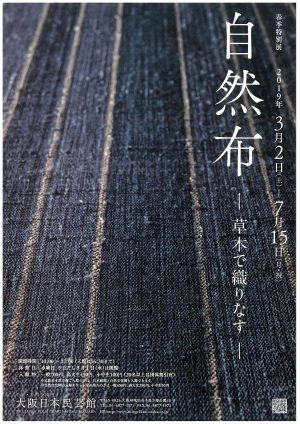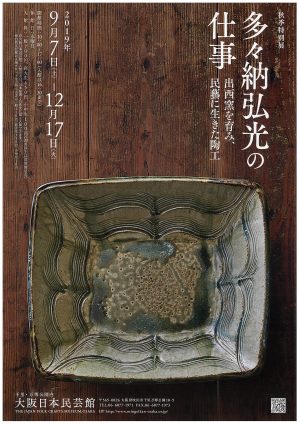秋季特別展 『多々納弘光の仕事―出西窯を育み、民藝に生きた陶工―』
秋季特別展「多々納弘光の仕事―出西窯を育み、民藝に生きた陶工―」
Click here for English.
会期:令和元年9月7日(土)~12月17日(火)
開館時間:10:00~17:00(入館は16:30まで)
休館日:水曜日
出西窯の創業メンバーの一人であり、2017年6月29日に惜しくもこの世を去った多々納弘光。窯元の顔としてよく知られる存在ですが、これまでひとりの作り手として注目されることは多くありませんでした。
弘光が出西窯で担っていた仕事は、主にハンドル(把手)付けと、型を使って成形する作品の製作。ハンドル付けにおいては、見た目の美しさとともに手に持った時の重量感や掴みやすさなどを重視しており、道具として使われることへの気配りを感じます。
また作陶において轆轤を用いなかったため、型物の製作には熱心に取り組みました。非常に多くの種類の型を作り、そこから形を取った陶器には櫛描、点打、縄文、指描きといった様々な技法の装飾が施されました。どの作品にも弘光の美意識が表れており、表現の幅や奥行き、愉しさを示す実例として見る者に驚きと感動を与えてくれます。
日中は出西窯の経営者としての仕事にも追われていたこともあり、工房に入るのは主に終業後、日が暮れてから。そのため作陶する姿を人に見られることは稀で、弘光は作陶には関わっていないと思っていた、という人さえいたのだそうです。
そんな「名もなき陶工」が続けていた、喜びにあふれた仕事の数々を、どうぞご高覧ください。
◇出西窯について◇
出西窯は、1947年8月に、井上寿人、影山千代吉、多々納弘光、多々納良夫、中島空慧によって島根県出雲市斐川町で創業しました。開窯初期から、民藝運動の同人達の指導を仰ぎながら歩んできた出西窯は、用に即した健康で美しい実用の器を作り続け、現在でも多くの人々から愛されています。第二展示室では、代表的な日常の器はもちろん、1948年の初窯の作品から、出西ブルーと呼ばれる呉須の作品群、プロダクトデザイナーの柳宗理が関わった柳宗理ディレクションシリーズなど様々な年代や種類の作品をご覧いただきます。時代の変化にも応じながら、民藝の理念を礎に、暮らしを彩る実用の陶器を作ってきた出西窯の軌跡を併せてお楽しみください。
〈併設展示〉
第2展示室 出西窯の作品
第3展示室 古伊万里そばちょこ
第4展示室 大型の編組品と染織品
《関連イベント》
◇記念講演会◇
「多々納弘光と民藝」
日時:10月20日(日)14:00~15:30(13:30開場)
講師:多々納真氏(出西窯代表・出雲民藝協会会長)
会場:国立民族学博物館・第5セミナー室(大阪日本民芸館向かい)
定員:100名(要予約)
聴講料:300円(別途大阪日本民芸館入館料が必要)
◇呈茶◇
担当:大阪日本民芸館友の会有志
日時:10月20日(日) 11:00~16:30
会場:大阪日本民芸館・渡り廊下
料金:500円(お抹茶とお菓子付)※別途入館料が必要、予約不要。
◇みんげいゼミ(少人数制の講座)◇
「山陰の陶窯―出西窯」
講師:中ノ堂一信氏(工芸史家、京都造形芸術大学客員教授)
日時:11月2日(土)14:00~15:30(13:30開場)
会場:大阪日本民芸館・会議室
定員:20名(要予約)
聴講料:300円(別途大阪日本民芸館入館料が必要)
「思い起こすままに―多々納弘光さんのこと―」
講師:山本教行氏(陶芸家、クラフト館岩井窯主宰)
日時:11月24日(日)14:00~15:30(13:30開場)
会場:大阪日本民芸館・会議室
定員:20名(要予約)
聴講料:300円(別途大阪日本民芸館入館料が必要)
◇はじめての「民藝」「民藝運動の広がりと全国の民芸館」◇
初心者の方に向けて、分かりやすく解説します。
日時:12月1日(日)14:00~15:30(13:30開場)
講師:小野絢子(大阪日本民芸館学芸員)
会場:大阪日本民芸館・会議室
定員:20名(要予約)
聴講料:300円(別途大阪日本民芸館入館料が必要)
◇ギャラリートーク(学芸員による展示解説)◇
9月15日(日)、28日(日)、10月14日(月・祝)、22日(火・祝)
11月10日(日)、30日(土)、12月7日(土)、15日(日)
各回:14:00~14:30
参加費:無料 (※別途入館料が必要、予約不要)
◇Upcoming Exhibition◇
Special Exhibition: The works of Hiromitsu Tatano, the late potter
who raised the Shussai-gama kiln and lived to realize the Mingei ethos
Sep 7th(Sat)-Dec 17th(Tue)
Hiromitsu Tatano was one of the founding members of the Shussai-gama Kiln. He passed
away on June 29, 2017.
A well-known face as the manager at the Shussai-gama Kiln, Tatano was never in the
spotlight as an individual potter.
By day he was mainly responsible for the production of pieces with handles and molded
pieces, but when the working day was over he could be found in the workshop after dark.
As he was seldom witnessed in the making process, there were those who thought that
Tatano himself was not involved in making pottery at all. For this reason he has been
called ‘the unknown potter’.
Tatano paid great attention to the balance of aesthetics, weight, and ease of use in
handled works. Eschewing a potter’s wheel, he strived to produce a wide variety of
molded pieces, decorating them with comb lines, dots, straw-rope and finger-painted
designs.
Every work possesses Tatano’s sense of beauty; a surprising and moving display of his
breadth, depth, and enjoyment of expression.
Please enjoy the beauty in the works of ‘the unknown potter’.
Shussai-gama kiln
Shussai-gama kiln was established in August 1947 by Hiromitsu Tatano, Hisato Inoue,
Chiyokichi Kageyama, Yoshio Tatano and Kuue Nakajima in Hikawacho, Izumo city, Shimane
prefecture. Since the beginning, they have followed the Mingei leaders in making
practical, wholesome and beautiful vessels that enhance everyday life and remain much
loved to this day. Gallery 2 displays the kiln’s first firings of 1947 as well as
their iconic cobalt blue works called “Shussai blue”, a series of works made under
the direction of Sori Yanagi and various other works. Please enjoy exploring the unfolding
trajectory which maintains the Mingei ethos in parallel with the changing times.
春季特別展 『自然布―草木で織りなす―』
会期:平成31年3月2日(土)~7月15日(月・祝)
開館時間:10:00~17:00(入館は16:30まで)
休館日:水曜日※ただし5月1日(水)は開館
 自然布とは、植物の繊維を用いて織りなされる布のことである。江戸時代中期に入って、国産の木綿が普及してくる遥か昔、人々は身の回りに自生する木々や草から糸を作り、布を織ってきた。布が登場したのは縄文時代からで、最初は編みによるものだったという。次いで、経糸と緯糸を用いた織物が始められた。材料は苧麻や大麻、藤、葛、科、楮などの他、北海道でオヒョウ、沖縄では芭蕉が使われ、和紙が生産されると紙縒りも糸として利用された。樹皮を剥ぐのは大変な力仕事で、これを煮たり叩いたりしながら柔らかくして繊維を取り出し、糸を績んで機を織っていく。苧麻や大麻の場合も、その労力は並大抵ではない。こうした仕事の多くは女性達によって行われ、少しでも着易い布になるように知恵が絞られた。地道で厳しい仕事を経て生まれる自然布は、それぞれの植物ならではの風合いが豊かにあらわれ、原始的で力強い魅力を放っている。本展では、日本各地の植物繊維を用いて織られた自然布を約70点紹介する。自然の恵みと厳しさがそのままにあらわれた自然布の世界をお楽しみください。
自然布とは、植物の繊維を用いて織りなされる布のことである。江戸時代中期に入って、国産の木綿が普及してくる遥か昔、人々は身の回りに自生する木々や草から糸を作り、布を織ってきた。布が登場したのは縄文時代からで、最初は編みによるものだったという。次いで、経糸と緯糸を用いた織物が始められた。材料は苧麻や大麻、藤、葛、科、楮などの他、北海道でオヒョウ、沖縄では芭蕉が使われ、和紙が生産されると紙縒りも糸として利用された。樹皮を剥ぐのは大変な力仕事で、これを煮たり叩いたりしながら柔らかくして繊維を取り出し、糸を績んで機を織っていく。苧麻や大麻の場合も、その労力は並大抵ではない。こうした仕事の多くは女性達によって行われ、少しでも着易い布になるように知恵が絞られた。地道で厳しい仕事を経て生まれる自然布は、それぞれの植物ならではの風合いが豊かにあらわれ、原始的で力強い魅力を放っている。本展では、日本各地の植物繊維を用いて織られた自然布を約70点紹介する。自然の恵みと厳しさがそのままにあらわれた自然布の世界をお楽しみください。
〈併設展示〉
第2展示室 日本の染織
第3展示室 古伊万里そばちょこ
第4展示室 近現代の作家達による染織品
《関連イベント》
◇記念講演会◇
「布と日本人」
講師:ひろいのぶこ氏(造形作家/染織研究)
日時:6月16日(日)14:00~15:30(13:30開場)
会場:国立民族学博物館・第5セミナー室(大阪日本民芸館向かい)
定員:100名(要予約)
聴講料:300円(別途大阪日本民芸館入館料が必要)
※定員に達した為、受付を終了しました。
◇呈茶◇
日時:6月16日(日)11:00~16:30
担当:大阪日本民芸館友の会有志
会場:大阪日本民芸館・2階渡り廊下
料金:500円(お抹茶とお菓子、別途大阪日本民芸館入館料が必要、予約不要)
※講演会後のお時間は混み合います。
◇みんげいゼミ(少人数制の講座)◇
「原始布・古代織の過去、現在、そして未来」
講師:山村幸夫氏(出羽の織座 米澤民藝館館長)
日時:5月19日(日)14:00~15:30(13:30開場)
会場:国立民族学博物館・第5セミナー室(大阪日本民芸館向かい)
定員:100名(要予約)
聴講料:300円(別途大阪日本民芸館入館料が必要)
※申し込み多数につき、会場を変更しました。
当日はお間違いの無いようにお越しください。
◇藤績みワークショップ「木綿以前・藤織りのこと」◇
講師:井之本泰氏(丹後藤織り保存会会長)、齋藤麻弓氏(保存会会員)
日時: 4月7日(日)
【午前】10:00~12:30 【午後】14:00~16:30
定員:15名(要予約)
料金:1200円(別途大阪日本民芸館入館料が必要)
◇はじめての「民藝」-「民藝」の始まりと柳宗悦-◇
初心者の方に向けて、「民藝」を分かりやすく解説します。
講師:大阪日本民芸館学芸員
日時:3月17日(日)14:00~15:30(13:30開場)
会場:大阪日本民芸館・会議室
定員:20名(要予約)
聴講料:300円(別途大阪日本民芸館入館料が必要)
◇ギャラリートーク(学芸員による展示解説)◇
3月9日(土)、24日(日)、4月13日(土)、21日(日)、5月4日(土・祝)、26日(日)、6月8日(土)、23日(日)、7月7日(日)、13日(土)
各回:14:00~14:30(別途大阪日本民芸館入館料が必要、予約不要)
◇Special Exhibition◇
Shizen-fu (Natural fabrics) -Weaving Plant Fiber Cloth-
Mar 2nd (Sat)-Jul 15th (Mon)
Shizen-fu is the name given to cloth woven from plant fibers as opposed to synthetics such as nylon.
Since long before cotton started to be produced here in Japan and became familiar in the mid-Edo period (18th c.) people have been taking fibers out of whatever plants they can find in their neighborhoods, spinning them into yarns and weaving them into cloth, for thousands of years.
In Japan, cloth appeared back in the Jomon period (8000 to 400 B.C.). At first it was knitted, then eventually it started to be woven using a warp and weft.
Ramie nettle, hemp, wisteria, kudzu vine, linden and paper mulberry have been widely used. Additionally, ohyo (elm) has been used in Hokkaido and banana fiber in Okinawa. As paper started to be produced, paper string was also used as yarn.
It is extremely tough work to peel bark. Then it must be boiled to soften it, and the fibers removed, and spun into yarn. In the case of ramie or hemp it is also very tough work to make them into cloth. Most of such work has been done by women and it is they who developed ways of making those tough materials comfortable to wear.
Shizen-fu (natural fabrics), the result of such hard work, bear each plant’s unique qualities in their distinctive texture and natural charm and exude the power of ancient techniques.
This exhibition presents some 70 works of plant fiber textiles from various parts of Japan.
Please enjoy the world of natural plant fiber cloth in which you can appreciate both the bounty and great hardship of nature.
Hours: 10:00 am – 5:00 pm (last admission 4:30 pm)
Closed: Wednesday


